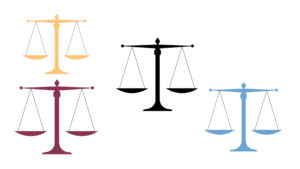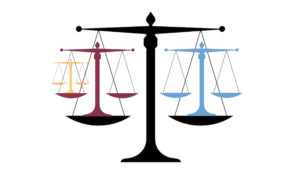I’ve been noticing that a recurring theme in my writing here is balance between opposites. I’ve written about balancing consumption vs. production in your life, and recently about balancing systems vs. goals for achieving what you desire. And I can think of a few more that I haven’t written about yet, that I’d like to touch on. It could become a pain to try to keep multiple balancing schemes in mind, but I thought if I could arrange most of it hierarchically, that would be much cleaner.
So instead of thinking about things like this:

It could be more like this, where each balanced dichotomy makes up a single node in a broader dichotomy: 
I don’t know how useful this will be, but if you like organizing and systematizing things, maybe you’ll find it fun.
This is also a chance to contextualize everything in Goals vs. Systems—we talked about the advantages of both, but isn’t there a proper time to do neither? Indeed sometimes we really seem to thrive doing neither.
Hierarchy of balance
Below is a giant tree structure, where each level of indentation indicates a deeper branch in the tree. Each list item describes the balance that has to happen beneath it. I think I’ll end up adding to this tree in the future.
- I think the fundamental level of balance is what I originally wrote about in the Consumerism series: production vs. consumption. That’s production and consumption of value—not just money, not just tangible goods, but the entire set of things people find valuable. This can be thought of as the balance between “doing work” and “treating yourself,” or the balance between “giving” and “taking.” Fundamentally it’s all of the meaningful “input” and “output” of you as a person. I happen to think the modern world is pushing us much too hard toward consumption, so a constant bias toward production is warranted.
- Production—within production, there’s a need to balance the structured kind with the whimsical kind. This contextualizes what I wrote about in Goals vs. Systems—even both of them together are not the whole picture. Pursuing goals and following systems are both structured acts—they involve planning ahead and keeping schedules. Primarily they involve conscious decisions that you make slowly and deliberately. But of course that’s not the only way we create value in our lives! There’s also unstructured productivity, like staying up writing until 4am, unplanned, because you felt inspired that night. Or dropping your plans and spending all day comforting a friend, because they needed it. That’s unstructured productive time, and often it’s your best productive time. But we can’t be whimsical all the time—we’re human, and we need some predictability in our schedules: for our health, for our ability to learn and grow, and (usually) for our ability to make money.
-
- Systems—I can’t think of any important subdivisions beneath this (yet).
-
- long-term goals—I can’t think of any important subdivisions beneath this (yet).
- short-term goals—I can’t think of any important subdivisions beneath this (yet).
- Unstructured productivity—I can’t think of any important subdivisions beneath this (yet).
-
- Consumption—within consumption, there’s a need to find balance between its two fundamental uses—either for direct pleasure, or as the raw material for future productivity. I wrote about this in Consumerism as well. Consumption-for-production includes all forms of education and research, seeking novel experiences to inspire creativity, buying parts, tools, and materials, etc.
- Consumption for production—I can’t think of any important subdivisions beneath this (yet).
-
- art—I can’t think of any important subdivisions beneath this (yet).
- entertainment—I can’t think of any important subdivisions beneath this (yet).
- Production—within production, there’s a need to balance the structured kind with the whimsical kind. This contextualizes what I wrote about in Goals vs. Systems—even both of them together are not the whole picture. Pursuing goals and following systems are both structured acts—they involve planning ahead and keeping schedules. Primarily they involve conscious decisions that you make slowly and deliberately. But of course that’s not the only way we create value in our lives! There’s also unstructured productivity, like staying up writing until 4am, unplanned, because you felt inspired that night. Or dropping your plans and spending all day comforting a friend, because they needed it. That’s unstructured productive time, and often it’s your best productive time. But we can’t be whimsical all the time—we’re human, and we need some predictability in our schedules: for our health, for our ability to learn and grow, and (usually) for our ability to make money.
Meta-balance
There’s one more layer of balance I’d add to this whole thing, and that’s how much you should even care about any of it. I think the root node above, the consumption-production ratio, is very important, but it’s not everything. There’s an ideal amount of time to spend thinking about it, and it’s certainly not all the time. Meta-balance means being measured or moderate in the degree to which you even bother trying to stay balanced in your life. Have fun with that infinite regress.


